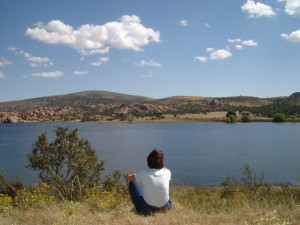Exploring the Twin Landscapes of Biophilic Learning

Originally appears in the Summer 2012 issue
Remember the last time your heart glowed at the sight of a sunrise erupting into the dark sky like fresh lava? Or perhaps when the sound of a twig snapping in nearby woods caused adrenaline to flood your bloodstream, preparing your feet for a hasty retreat? These are manifestations of an exchange between people and the natural world as old as humanity itself. We harbor an innate need to affiliate with the habitats, creatures, and processes of the natural world. This need has been called biophilia. We can think of biophilia as the genetic legacy that is a portal between the psychic landscape that inhabits us and the physical landscape that we inhabit. We are equipped with a repertoire of responses to adapt to the promise and peril that nature poses. These responses, for example, include our instinct, both conscious and subconscious, to move away from wild creatures or violent weather that could harm us. Conversely, other biophilic responses prompt us to follow our eyes, nose, or taste buds to fruits or roots that ease our hunger or water to slake our thirst. The biophilic responses are expressions of our ancient capacity to go with the flow of nature’s ever-changing dynamics.
Even today, our biophilic responses can contribute to the quality of our lives in a variety of different ways. First, these built-in ‘response-abilities’ can enrich and deepen our relationship with nature and our overall sense of well-being. Second, through simple activities, these capacities can be more fully expressed in ourselves and in those with whom we work by enhancing our sense of mental well-being. Third, fulfilling our biophilic legacy also holds the promise of completing a circle of reciprocity that encourages us to give something back to nature in return for all that nature gives to us. Doing so can cause a change in the climate of our contemporary culture that also could help to mitigate negative change in the physical climate of the planet.
To view the photo-rich magazine version, click here.
If you are not already a subscriber, please subscribe to read the full article
Terril Shorb is a senior faculty member of the Adult Degree Program at Prescott College where he created the Sustainable Community Development program and teaches the Children and Nature course online. With his wife, he is co-founder of the nonprofit Native West Press (www.nativewestppress.org) and is also the co-creator of the Kellert-Shorb Biophilic Values Indicator, now being used as a conservation education tool. Terril lives in the central Arizona highlands with an amazing cast of wild l
Leave a Reply
You must be logged in to post a comment.





